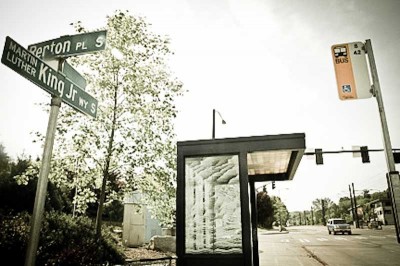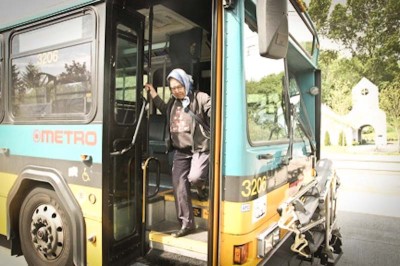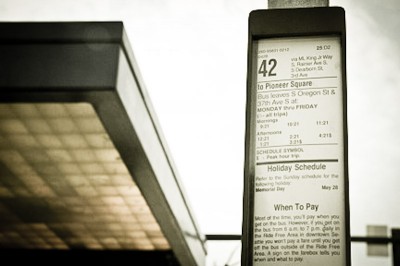
Getting from point A to point B isn’t easy for 68-year-old Tuyet Mhi Mai. Especially when those points are her daughter’s crowded Lake City home and service classes or work in South Seattle.
Since the King County Metro reduced bus route 42 because it runs parallel to the Light Rail, Mai’s commute is a little more complicated and time-consuming.
For South Seattle’s public-transit-dependant immigrant communities, saving bus 42 isn’t just about one bus route. It’s about getting King County Metro and the county council to understand its transportation needs.
Representatives from King County Metro say they’re listening – or at least trying to. But the balance between providing efficient, cost-effective bus routes and meeting the needs of groups facing language and cultural barriers isn’t easy.

Thirty six years ago, decades before she came to the United States from Ho Chi Minh, Vietnam, Mai survived a car accident that killed her husband and left her with a stiff leg. Now she walks with a cane, and even going a few blocks on foot is a struggle. So her commute to classes at Asian Counseling and Referral Services (ACRS) takes a whopping two hours each way.
“I know that I can take the Light Rail to Mt. Baker [station],” Mai said through a translator, acknowledging her roundabout route. “But I cannot walk that far [from the station to ACRS], even though it’s only three blocks.”
Instead she rides the Light Rail past Mt. Baker Station, which is only a few blocks away from ACRS, to the Columbia City Station and then catches bus 8 or 42 from there back the way she came to the bus stop right outside ACRS. But now the 42 only runs about once an hour from 9 a.m. to 5 p.m. on weekdays, extending her commute.
Mai is probably eligible for some of King County Metro’s specialized transportation services, like the Metro Access Transportation Service, which was started to help the disabled. But she says she hasn’t heard of the program.
Her lack of awareness reflects the disconnect that some of South Seattle community groups feel between themselves and King County Metro – that their voices aren’t being heard, that concerns aren’t being met. It’s a disconnect that King County Metro is trying to fix with community outreach and dialogue.
Feeling unheard
When the Light Rail started running from Sea-Tac to Westlake Station in 2009, King County Metro planned to shuffle or axe buses with routes redundant to the rail.

Bus 42 was one of 30 such routes. Metro extended bus 8, which runs from Seattle Center to Rainier Beach, to support the changes made to bus 42.
But there was still a ton of public outcry to keep bus 42, which ran from Skyway to the Pioneer Square area and gave service along the Martin Luther King Way South corridor – through zipcode 98118, one of the most diverse areas in the nation.
The protest came from groups like ACRS, Pacific Asian Empowerment Program, Transportation Choices and the Filipino American Political Action Group of Washington (FAPAGOW).
“The community was caught off guard,” said Shefali Ranganathan, program director of Transportation Choices. “People showed up to their bus stop and saw it was discontinued.”
Ranganathan said that the community thought the Light Rail would be an addition to existing bus routes.
The lack of signs in other languages besides English, as well as the mile-long distance between stations, make the Light Rail less-than-desirable for some.
“Bus 42 primarily serves basically low-income [people] who don’t have a vehicle to get around,” said Celso Tolman, president of FAPAGOW.
County council members ordered Metro to defer eliminating the route until February 2013, after they had reached out to South Seattle’s communities about transportation issues.
Victor Obeso, manager of service development for King County Metro says they’re looking for ways to give better information to limited English-speaking communities and to make ORCA cards more accessible.
“We know it’s a challenge for any of our riders when we make changes to service or changes to their ridership patterns,” Obeso said. “It’s particularly challenging to immigrant communities who have limited abilities to comprehend English, or who for cultural reasons don’t connect to our customer service as other riders might.”

Bus route 42, which costs about $210,000 to $300,000 a year to operate in its current route, is attracting about a hundred riders each day, according to Obeso. That’s down from the 3,500 to 3,700 boardings the old route 42, which extended from Skyway, used to see.
But people in favor of keeping or restoring route 42 say that the drop in numbers is caused by the cuts to the route – not the other way around.
An uncertain future
Finding a solution to the issue around bus 42 isn’t easy. King County Council member Larry Gossett, who rallied to keep bus 42 intact, isn’t hopeful for the route’s future.
“Essentially it’s an uphill battle to try to change the decision at this time,” Gossett said.
King County Metro wants to encourage Light Rail ridership with more outreach and by giving access to ORCA cards. But that might not be the response the community is looking for.
“We want people to get on the light rail, but I think there needs to be recognition that the Light Rail isn’t always the best option for some transit-dependant people,” Ranganathan said.
Ranganathan suggests a smaller bus shuttle that can service the International District and cut down on the walk that’s up hill to the 8 or down hill to the Light Rail. She also suggests changing or adjusting existing routes to meet the needs of the community members.
“We just want the transit in South Seattle to work better for folks, because there’s clearly an unmet need.”
This post was produced in partnership with UW Election Eye and CityClub.

